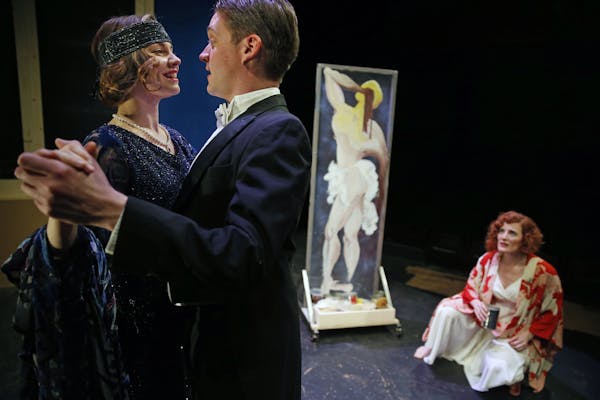F. Scott and Zelda Fitzgerald's turbulent relationship is the subject of "This Side of Paradise." The 2010 off-Broadway musical had its regional premiere last weekend in an absorbing History Theatre production in St. Paul. Book writers Nancy Harrow and Will Pomerantz focus from Zelda's perspective as she sits in a sanatorium in 1940, the year of Fitzgerald's death. Figures from their mutual past flow onto the stage to embody her tormented memories. Harrow composed the music and wrote the lyrics.
The story unfolds as Zelda (Norah Long) remembers the 1918 Alabama country club dance where young Zelda Sayre (Kendall Anne Thompson), meets Fitzgerald (Bradley Beahen), a dashing army officer. She rebuffs his marriage offers because he lacks status, income, and prospects. He's merely a St. Paul Fitzgerald rather than one of the elite Oyster Bay Fitzgeralds.
Once his fortunes improve, they wed and dazzle New York's 1920s Jazz Age social scene. Unfortunately, as his literary star rises, the couple's thirst for notoriety and alcohol increases exceedingly.
Two sequences vividly impress — the fabled competitive friendship between Fitzgerald and Ernest Hemingway (a vibrant Eric Knutson) and Zelda's resentment of their bond. Each are theatricalized in boxing-match and tug-of-war images shaped by the actors. A scene with the couple's young child, Scottie (an endearing Dora Dolphin), stuns when Young Zelda tyrannizes her for incorrect ballet moves.
Alan Sorenson intuitively steers much of the action as Zelda's psychiatrist, Doctor Cassell. Long's soulful portrayal captures the smoky elegance of Harrow's score. Beahan's Fitzgerald intrigues as a man whose charm shrewdly obfuscates his narcissism. Though Thompson's voice is often pitched too low, she exudes flirtatious zest in a role underdeveloped by the writers. Emily Scinto is touching as the teenaged Scottie, who forgivingly recounts her mother's misery.
Director Ron Peluso fluidly navigates the many scenes with deft transitions between flashbacks and 1940. Kathy Kohl's precise period costumes enhance the Jazz Age spirit fittingly contrasted by Rick Polenek's clinically cold sanatorium set design.
The balance between music director Andrew Fleser's dreamy jazz quartet and the acting ensemble's strong vocals is spot-on. We hear every lyric. Standout tunes include "Lost Lady" and "Dear Max." Regina Peluso's saucy choreography draws from the Charleston and other 1920s dance standards.
John Townsend writes about theater.

Minnesota Sports Hall of Fame: A class-by-class list of all members

This retired journalist changed professional wrestling from Mankato

